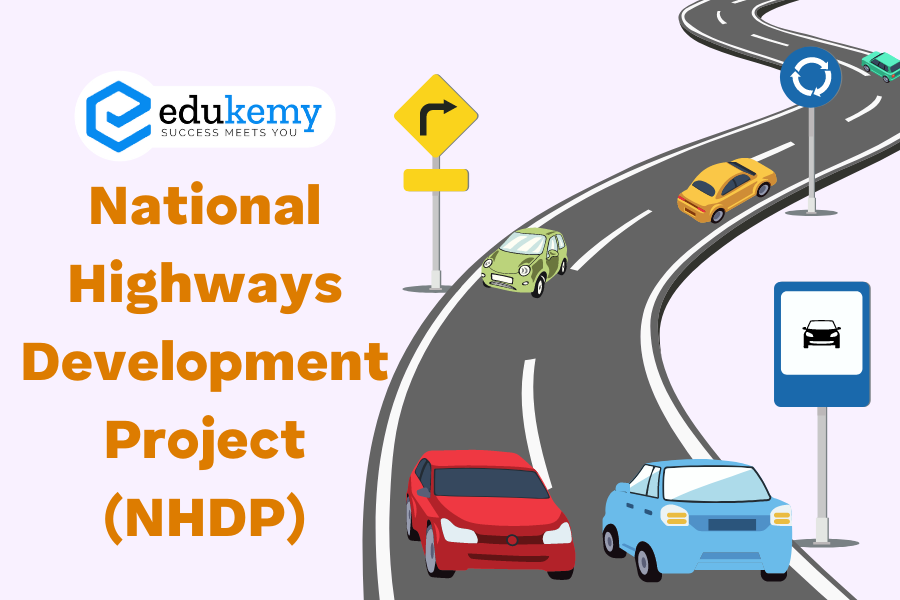
- The National Highways Development Project (NHDP) is a significant initiative launched in 1998 by the Government of India.
- The primary objective is to upgrade, rehabilitate, and widen major highways across the country to enhance connectivity and promote economic development.
Key Points:
- Initiation: The project began in 1998 and is overseen by the National Highways Authority of India (NHAI) under the Ministry of Road, Transport, and Highways.
- Scope: The NHDP encompasses a vast network of roads and highways, totaling 49,260 km. The focus is on comprehensive road development to contribute to the economic growth of the nation.
- Golden Quadrilateral: A notable component of NHDP is the Golden Quadrilateral, covering a distance of 5,846 km. This network connects four major cities: Delhi, Mumbai, Chennai, and Kolkata. The Golden Quadrilateral is integrated into the larger Bharatmala project.
- North-South and East-West Corridors: These corridors are integral parts of NHDP and involve the development of national highways connecting the four extreme points of the country.
- North-South Corridor: Connects Srinagar in the north to Kanyakumari in the south.
- East-West Corridor: Links Porbandar in the west to Silchar in the east.
- North-South East-West Corridor (NS-EW):
- Considered the largest ongoing highway project in India.
- Part of the second phase of NHDP.
- Involves the construction of 7,300 km of four/six-lane expressways.
- Connects key locations such as Srinagar, Kanyakumari, Kochi, Porbandar, and Silchar.
- Managed by the National Highways Authority of India.
Future Integration:
- The government has planned to conclude the NHDP program and incorporate it into the larger and more comprehensive Bharatmala project.
Conclusion:
- The NHDP has played a crucial role in transforming and expanding India’s highway infrastructure. By linking major cities and establishing key corridors, it contributes to the economic development of the country. The integration of NHDP into the Bharatmala project reflects a strategic and cohesive approach to nationwide infrastructure development.
FAQs
1. What is the National Highways Development Project (NHDP)?
The National Highways Development Project (NHDP) is a flagship initiative by the Government of India aimed at upgrading and expanding the country’s road network. Launched in 1998, NHDP focuses on improving connectivity, enhancing road safety, and promoting economic development by constructing and upgrading national highways across India.
2. What are the key objectives of NHDP?
NHDP has several objectives:
- Enhancing connectivity between major cities and ports to facilitate smoother movement of goods and passengers.
- Upgrading existing highways to modern standards to improve safety and reduce travel time.
- Developing expressways and bypasses to ease congestion and promote faster transportation.
- Promoting regional development by connecting remote areas to major economic hubs.
- Encouraging private sector participation through Public-Private Partnerships (PPPs) for efficient project implementation and maintenance.
3. How is NHDP structured?
NHDP is structured into multiple phases, each focusing on specific aspects of highway development:
- Phase 1: Focuses on Golden Quadrilateral connecting Delhi, Mumbai, Chennai, and Kolkata, and North-South & East-West corridors.
- Phase 2: Includes the development of highways connecting major cities and industrial hubs.
- Phase 3: Targets the construction of expressways and high-density corridors to reduce travel time and congestion.
- Phase 4: Aims at improving connectivity to remote areas and border regions, enhancing national security and regional integration.
- Phase 5: Emphasizes on the development of additional routes, bridges, and tunnels to address growing traffic demands.
4. How is NHDP funded?
NHDP receives funding from various sources including:
- Government budget allocations.
- Loans from domestic and international financial institutions.
- Toll revenue generated from the operation of highways.
- Private sector investments through PPPs, Build-Operate-Transfer (BOT) models, and other concession agreements.
5. What are the benefits of NHDP?
NHDP has brought several benefits to India:
- Improved connectivity has boosted trade and economic growth by facilitating the movement of goods and people.
- Enhanced road infrastructure has reduced travel time, fuel consumption, and vehicle operating costs.
- Increased road safety measures have lowered accident rates, saving lives and reducing injuries.
- NHDP has created employment opportunities during construction and maintenance phases, contributing to socio-economic development.
- Better accessibility to remote regions has promoted tourism, agriculture, and other industries, fostering balanced regional development.
In case you still have your doubts, contact us on 9811333901.
For UPSC Prelims Resources, Click here
For Daily Updates and Study Material:
Join our Telegram Channel – Edukemy for IAS
- 1. Learn through Videos – here
- 2. Be Exam Ready by Practicing Daily MCQs – here
- 3. Daily Newsletter – Get all your Current Affairs Covered – here
- 4. Mains Answer Writing Practice – here

